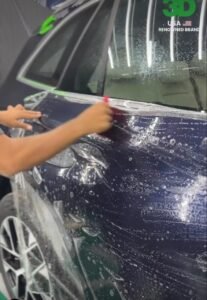When it comes to preserving the beauty and shine of a car’s surface, protective coatings are a game changer. While nanocoatings have been widely used in the detailing industry for years, a new innovation is now redefining car care standards- graphene coating for cars. But what exactly is graphene coating, and how does it compare to traditional nanocoating? Let’s explore the key differences and understand why graphene coating is becoming the top choice among car enthusiasts.
What Is Nanocoating?
Nanocoating is a protective layer formed by microscopic particles that bond to the surface of the car. These particles usually consist of ceramic, silica, or polymer-based compounds. The result is a hydrophobic and scratch-resistant shield that keeps the car safe from dust, water, and light abrasions. Nanocoating offers a decent level of protection and a glossy finish, making it a popular choice for short- to medium-term car care.
However, nanocoating does have its limitations. It may lose its shine and effectiveness over time, especially under harsh weather conditions or improper maintenance. The durability generally ranges between 1 to 2 years, requiring regular reapplication.
Understanding Graphene Coating for Cars
Graphene coating is the latest advancement in automotive protection. Derived from a single layer of carbon atoms arranged in a hexagonal lattice, graphene is incredibly strong, flexible, and thermally conductive. When applied to a vehicle, graphene coating for cars forms a robust and long-lasting barrier that delivers exceptional protection against UV rays, heat, water spots, and scratches.
Unlike nanocoating, graphene coating utilizes the unique molecular structure of graphene to provide enhanced resistance to contaminants and better surface bonding. Its anti-static properties also help repel dust and reduce the need for frequent cleaning.
Key Differences Between Graphene Coating and Nanocoating
-
Durability and Lifespan:
Graphene coatings last significantly longer than nanocoatings. While a typical nanocoating lasts up to 2 years, graphene coating for cars can easily protect the surface for 3–5 years with proper care.
-
Scratch Resistance:
Thanks to its superior strength, graphene coating provides better protection against fine scratches and swirl marks, especially those caused by washing or environmental factors.
-
Heat Dissipation:
One of the standout features of graphene coating for cars is its excellent heat dissipation. This quality reduces surface temperature and minimizes the risk of paint damage from long sun exposure—something nanocoatings struggle with.
-
Water Spot Resistance:
Graphene’s hydrophobic nature ensures that water beads up and rolls off the surface easily. More importantly, it minimizes water spotting, which is a common problem with ceramic-based nanocoatings.
-
Finish and Appearance:
While nanocoating provides a glossy shine, graphene delivers a deeper, more reflective finish that enhances the car’s natural color. Dark-colored vehicles especially benefit from this intense gloss.
-
Application and Cost:
Nanocoating is relatively easier and cheaper to apply, making it suitable for those on a budget. However, for those seeking premium, long-term results, investing in graphene coating for cars is worth every penny.

Why Graphene Coating Stands Out
The reason graphene coating for cars is gaining popularity isn’t just due to its durability—it’s the overall value it brings. Car owners who choose graphene coating enjoy a longer-lasting shine, reduced maintenance needs, and better protection against the elements. It’s a smart choice for those who see their vehicles as more than just a means of transport, but as valuable assets worth preserving.
Conclusion
While nanocoating has served its purpose well over the years, graphene is paving the way for the future of car surface protection. With enhanced performance across all critical parameters—durability, scratch resistance, water repellence, and aesthetics—graphene coating for cars is clearly the superior option. If you’re looking to elevate your car care game, it’s time to make the switch and experience the power of graphene.

